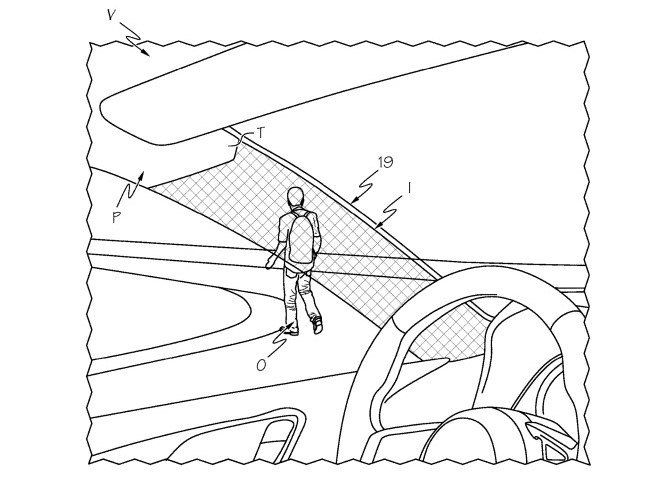Bulky A-pillars Getting in the Way? Toyota Has a Clear Solution

Back in the days of sky-high tailfins and wraparound windshields, A-pillars weren’t of sufficient thickness to hide little Timmy riding his bike, or maybe that Ford Fairlane approaching from behind that shrub to your left. No, front seat vision was grand — trying to stop your Detroit barge with unassisted drums brakes was the real challenge.
These days, the high-strength steel and airbags needed for rollover and side-impact protection have turned those slim pillars into Corinthian columns capable of hiding a small crowd. A-Pillars are bulky, and that’s a safety problem in itself.
What to do? In Toyota’s case, simply develop a way of seeing through them.
According to a patent application filed to the U.S. Patent and Trademark Office by Toyota’s American engineering arm, the automaker hopes to give drivers a way of seeing past those intrusive beams. No, Toyota isn’t patenting honeycomb pillars. (That apparently Genesis’ job.)
Toyota’s plan is to have light bend around the pillar, thus making it disappear from view. Freaky stuff, but not the time-bending pseudo-science of Philadelphia Experiment folklore. The “cloaking device” in the company’s patent uses a far simpler and cheaper solution: carefully arranged mirrors.
By reflecting what’s behind the A-pillar onto the interior surface of the pillar, the obstruction all but vanishes, leaving the driver looking at little Timmy or that errant Fairlane instead. Toyota explains it a far more technical, albeit confusing way:
A cloaking device includes cloaking region boundary planes oriented non-planar to each other, each of the cloaking region boundary plans having an outward facing mirror surface and an outward facing opaque surface. The cloaking device includes a cloaking region bounded at least partially by the inward facing opaque surfaces of the cloaking region boundary planes. Half mirrors are spaced apart and generally parallel to the outward facing mirror surfaces such that a half mirror is spaced apart and generally parallel to each outward facing mirror surface. Light from an object on an object-side of the cloaking device is directed around an article within the cloaking region and forms an image on an image-side of the cloaking device such the article appears transparent to an observer looking towards the object.
Got it?
The patent application describes the cloaking device as a cost-conscious alternative to pricey video display technology under development by other automakers. Presumably, the mirrored surfaces wouldn’t interfere with the pillar-mounted airbag.
Whether or not we’ll see these see-through pillars in a future Toyota or Lexus vehicle remains to be seen (or not, ha ha), so for now we’ll have to be content with the above drawing.
[Images: Toyota]

More by Steph Willems
Latest Car Reviews
Read moreLatest Product Reviews
Read moreRecent Comments
- Wjtinfwb 157k is not insignificant, even for a Honda. A lot would depend on the maintenance records and the environment the car was operated in. Up to date maintenance and updated wear items like brakes, shocks, belts, etc. done recently? Where did those 157k miles accumulate? West Texas on open, smooth roads that are relatively easy on the chassis or Michigan, with bomb crater potholes, snow and salt that take their toll on the underpinnings. That Honda 4 will run forever with decent maintenance but the underneath bits deteriorate on a Honda just like they do on a Chevy.
- Namesakeone Yes, for two reasons: The idea of a robot making decisions based on algorithms does not seem to be in anyone's best interest, and the thought of trucking companies salivating over using a computer to replace the salary of a human driver means a lot more people in the unemployment lines.
- Bd2 Powertrain reliability of Boxer engines is always questionable. I'll never understand why Subaru held onto them for so long. Smartstream is a solid engine platform as is the Veracruz 3.8L V6.
- SPPPP I suppose I am afraid of autonomous cars in a certain sense. I prefer to drive myself when I go places. If I ride as a passenger in another driver's car, I can see if that person looks alert and fit for purpose. If that person seems likely to crash, I can intervene, and attempt to bring them back to attention. If there is no human driver, there will probably be no warning signs of an impending crash.But this is less significant than the over-arching fear of humans using autonomous driving as a tool to disempower and devalue other humans. As each generation "can't be trusted" with more and more things, we seem to be turning more passive and infantile. I fear that it will weaken our society and make it more prone to exploitation from within, and/or conquest from the outside.
- JMII Based on the human drivers I encounter everyday I'll happily take my chances with a computer at the wheel.The highway driver assist system on my Santa Cruz is great, it can self drive perfectly in about 90% of situations. However that other 10% requires you to be in control and make decisions. I feel this is the problem with an AI driving a car, there are times when due to road construction, weather conditions or other drivers when only a human will know what to do.



































Comments
Join the conversation
Jaguar/Land Rover had one of these as a concept back in 2014 called "360 Virtual Urban Windscreen system". It used screens instead of mirrors, but it had the same result. I wonder if they patented it?
people still look out the windshield? every driver i see these days is staring at their phone